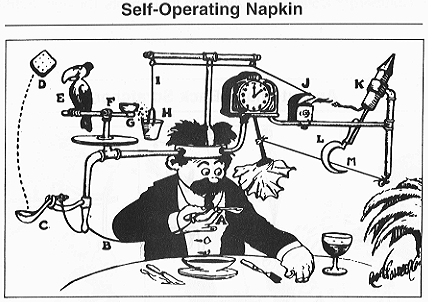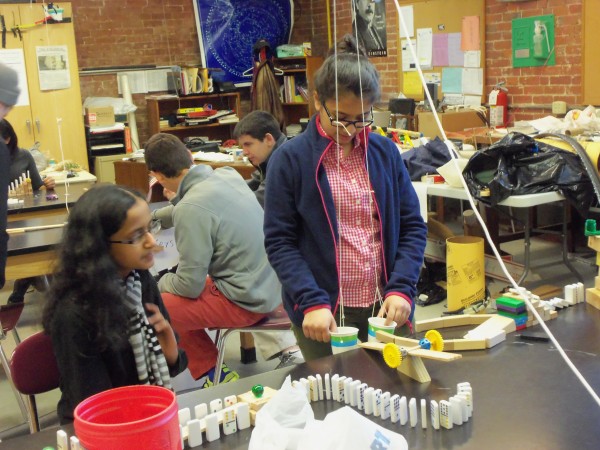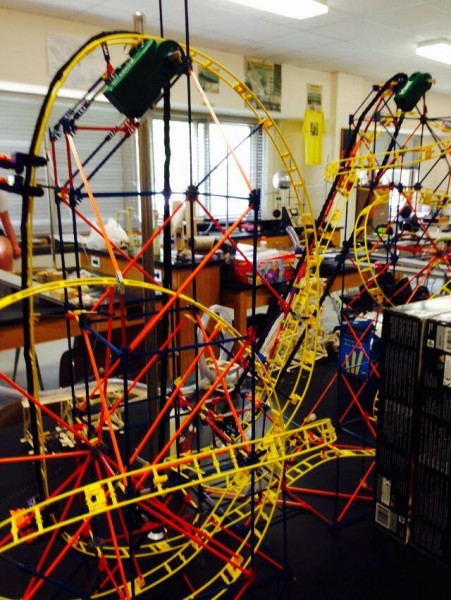Making, With a Rube Goldberg Twist
Building contraptions inspired by the inventor and cartoonist teaches students about physics, problem-solving, and cause and effect.

A Rube Goldberg comic depicts the Self-Operating Napkin, one of Professor Lucifer G. Butts's most famous inventions.
Remember when Chunk comes to Mikey’s house at the beginning of The Goonies and the front gate is opened with a series of chain reactions including levers, pulleys, a bowling ball, and a chicken laying an egg? Hello, Rube Goldberg machine. Reuben Garret Lucius “Rube” Goldberg was a cartoonist and inventor. Known for his cartoons that depicted a screwball inventor, Lucifer Gorgonzola Butts, who devised wildly complicated inventions to complete simple tasks, Goldberg has inspired countless tinkerers to start building. In popular culture, we see these contraptions in movies, television, and cartoons.
Students at Worcester (MA) Academy built a Rube Goldberg machine with dominoes, levers, and ramps that deposited a knife into a container of butter.
Purdue University began an annual Rube Goldberg machine competition in the late 1980s and student inventors appeared on Jimmy Kimmel Live a few years ago demonstrating their “zip a zipper” invention. The MIT Museum, Carnegie Science Center, and University of California, Berkeley also host contests. Rube Goldberg Inc., run by Goldberg’s granddaughter Jennifer George, creates annual challenges—for instance, hammer a nail, make a cup of coffee, and many more—that university groups like these, as well as high school students, can pay a fee to enter. Purdue University students demonstrate their winning "zip a zipper" machine.Students rise to the challenge
But you don’t have to enter a national contest to enjoy these pursuits. As maker spaces become more prevalent in schools, librarians and teachers are incorporating Rube Goldberg-style machine building and design into their curricula. When students put together these often low-tech creations, they learn about cause and effect and chain reactions, as well as simple mechanics, gravity, motion, and force. The trial and error, revision, and reiteration involved make this a quintessential maker activity. Judy Houser from Holy Trinity Episcopal Academy in Melbourne, FL, has been engaging middle school students in these pursuits for the past couple of years. When asked why building complex contraptions like these is important, she says, “We don’t know what jobs students will have in the future. Building Rube Goldberg machines provides opportunities for students to come up with their own process to solve a problem.”
A contraption by students at Islip (NY) High School used K'Nex, pulleys, and ramps to pop a balloon.
Houser’s library maker space has a Rube Goldberg area where students can design and build. They have used LEGOs, littleBits, K’Nex, marbles, golf balls, and gears from the maker space in their machines, and if the library doesn’t have a needed material, they engineer it. Their inventions include a littleBits-powered machine that knocks over a tower of blocks and a battery-operated toy train that triggered a littleBits-powered fan to blow confetti out of a volcano. Every year, Houser’s library hosts an Innovation Day for fifth and sixth graders. Last year, students designed and built a machine that dropped Mentos candies into a bottle of soda, demonstrating a popular science experiment using a series of levers, pulleys, and ramps. Each year at Islip (NY) High School, librarian Gina Seymour works with physics teachers and students on their annual final project. Students use the school library to research concepts—such as circuits, magnets, electricity, and gravity—they have learned about in physics class, and then they construct a machine. The library loans materials from the maker space for the construction phase. Popular items include littleBits, K’Nex, and recyclables from the library, according to Seymour; some students used K'Next, ramps, and pulleys to build a machine that pops a balloon. “We foster creativity through artistic expression,” she says.rev up your makers
Students typically encounter many challenges designing and building these process-focused inventions. For one, “Sometimes students are stymied by the creative license they have,” says Susanne Broderick, middle school math teacher at Worcester (MA) Academy. She recommends that they gain an understanding of simple machines and how they work before beginning to design and build. To prepare her students, Houser shows them “This Too Shall Pass,” a music video by the band OK Go featuring a giant, continuous, three-and-a-half minute Goldberg machine reaction. She also reads them Melissa Sweet’s picture book Balloons Over Broadway: The True Story of the Puppeteer of Macy's Parade (HMH, 2011) and shows them videos from the YouTube series"Cracking Contraptions," featuring clips excerpted from the animated “Wallace and Gromit” films. Wallace is an inventor and builds wacky contraptions such as a grocery cart that shops on its own and the Snowmanotron, a machine that builds a snowman. OK Go's music video featuring a massive Rube Goldberg machine. The band also promoted the White House Maker Faire. Students can also practice creating these contraptions with the Rube Works app ($2.99, iOS and Android), available at Rube Goldberg, Inc. Those using Rube Works can log in to play games and puzzles and turn scenes from Goldberg’s comics into their own virtual machines. A toolbox provides materials for each puzzle with guided suggestions on how to use each item. A test button allows users to repeatedly test their machine to gauge success and failure, a critical aspect of this type of building. The app explores many everyday tasks, including ones featured in the national competition, which can be completed with these machines: Erase a chalkboard. Water a plant. Squeeze orange juice. The possibilities are endless. Wallace's Snowmanotron in action.Tips for top machines
Successful inventions take time and planning. Broderick encourages students to keep a design journal to track their thought processes and the evolution of their creation. Make sure students understand that building these contraptions is a process of trial and error. Be available to students to discuss their plans and challenges. When they are stuck, walk through each variable with them, considering what might be changed to create a working, successful machine. Collect as many materials as possible, because “kids will want and need items you cannot anticipate,”Have your students taken on a
Rube Goldberg-style challenge?
Tell us about it in the comments section.
 Jennifer Hanson is director of library services at Worcester Academy in Massachusetts.
Jennifer Hanson is director of library services at Worcester Academy in Massachusetts. RELATED
RECOMMENDED
CAREERS
The job outlook in 2030: Librarians will be in demand
CAREERS
The job outlook in 2030: Librarians will be in demand
ALREADY A SUBSCRIBER? LOG IN
We are currently offering this content for free. Sign up now to activate your personal profile, where you can save articles for future viewing





Add Comment :-
Comment Policy:
Comment should not be empty !!!
Linda L.
Our school has for many years has a week of Rube Goldberg camp. The creations take over the gym as the students make increasingly complex designs using a multitude of mostly found or recycled items. It concludes with a presentation of all the projects, all of which are videoed so that the kids can enjoy their achievements over and over again. it is one of our most popular camps.Posted : Mar 02, 2016 01:17